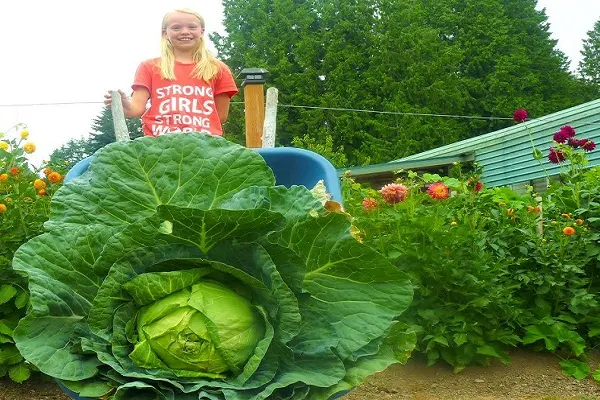How to grow cabbage giant size - Cabbage has many interesting features. One of them consists in the fact that under favorable growth conditions , it can produce cabbage weighing 25 kilograms or more. For this it is best to take the cabbages Moscow late -15 and Far East .
It is important to prepare the soil. Since autumn digging manure - about 5-10 kg/m2 spring in an area with high groundwater table prepared ridge, dry is not necessary. Seedlings are best grown in small pots. To select the best planting plants with 3-4 true leaves.
Planted after transplanting of early varieties of cabbage. For better development of plants need a large area of supply , which is packed into a hole staggered aisles 90-100 cm This is the most convenient for subsequent work . In the 10-14 cm depth of the wells is mixed well with the mail 2-3 handfuls of manure. Mineral fertilizers are applied at the rate of 30-40 g of ammonium nitrate , 30-50 g of double superphosphate , 20 - 25 g of potassium salt per 1 m2. It is impossible to form a fertilizer prevailed . Planted seedlings to lower leaves , in a pre- watered well. Gently pushing the soil , forming a well for the next watering. Even during the dry one watering enough to seedling well caught . Too frequent watering soil compaction and practically useless.
Caring for future giant cabbage in the early stages does not differ from conventional agricultural techniques of cultivation of plants: regular weeding , loosening after rain and irrigation . With the advent of the 7- 8 -leaf stage cabbage spud to the lower leaves , usually after rain. In dry weather before hilling beds watered abundantly . We must remember that ridging dry soil does not cause additional root formation in plants and will only serve to keep the plant upright.
If you can not care for cabbage leaves damaging healthy until harvest.
Once a week, visiting plants , pests are harvested by hand , and if this is not possible , they are treated with appropriate medication .
In late July, the growth of cabbage increases, since that time and begins the main work on the cultivation of giant cabbages . To do this, every seven days to be fed mullein (1 : 10), or bird droppings (1 : 15). Do it after a good rain or watering. If you moisten the soil well in the evening , the day after can fertilize and loosen the morning and that did not form a crust , sprinkle with dry earth . Thus watered at least 4 times . Feeding , avoid fertilizers on cabbage leaves .
When growing giant forks do not forget to leave a few plants where cabbage grown by conventional farming practices - should in fact know what you've achieved .
How to grow cabbage giant size ?
Growing giant cabbages requires careful planning and attention to detail, from selecting the right seeds to providing optimal growing conditions. Here’s a comprehensive guide on how to achieve impressive cabbage sizes.
Steps to Grow Giant Cabbages
Choose the Right Variety
Select varieties known for producing large heads, such as Danish Ballhead, Savoy Perfection, or specific hybrids designed for size.
Late-season varieties tend to grow larger and are better suited for storage.
Prepare the Soil
Soil Quality: Cabbages thrive in rich, fertile soil with a pH of 6.0 to 7.5. Amend your soil with plenty of organic matter like compost or well-rotted manure before planting.
Soil Preparation: In the fall, prepare your cabbage bed by digging deep and mixing in sand, peat moss, bone meal, composted manure, and wood ashes to improve drainage and nutrient content.
Moisture Retention: Incorporate materials that help retain moisture without compacting the soil, which is crucial as cabbages grow large.
Start Seeds Indoors
Begin seeds indoors about 8 weeks before the last frost date. Use seed trays and maintain a temperature of around 70°F (21°C) for germination.
Once seedlings have developed their first true leaves, transplant them into larger pots to promote root growth.
Transplanting
Transplant seedlings outdoors when they are about 4-6 inches tall and after the danger of hard frost has passed. Harden off seedlings by gradually exposing them to outdoor conditions for about a week before planting.
Dig holes large enough to accommodate the root ball and add a bit of water to each hole before planting.
Spacing and Watering
Space plants at least 24 inches apart to allow ample room for growth. This spacing helps prevent competition for nutrients and water.
Water consistently, aiming for about 1 inch per week. Consider using a watering system that delivers moisture directly to the roots without wetting the leaves, which can lead to disease.
Fertilization
Fertilize with a balanced fertilizer (like 8-32-16) at transplanting time and again during the growing season as needed4. Organic options include compost teas or liquid fertilizers applied weekly through a watering system.
Avoid over-fertilizing, which can lead to excessive leaf growth at the expense of head development.
Provide Adequate Sunlight
Ensure your cabbages receive at least 6-8 hours of direct sunlight daily. They can tolerate some shade but will produce larger heads in full sun.
Pest Control
Monitor for pests such as aphids, cabbage worms, and slugs. Use organic pest control methods like iron phosphate for slugs or insecticidal soap for other pests.
Harvesting
Harvest cabbages when they reach their desired size but before they split or become too mature. Use a sharp knife to cut them from the base carefully.
Growing giant cabbages is achievable with the right preparation and care. By selecting suitable varieties, preparing nutrient-rich soil, providing adequate water and sunlight, and managing pests effectively, you can cultivate impressive cabbages that will be a highlight of your garden.


Comments
Post a Comment